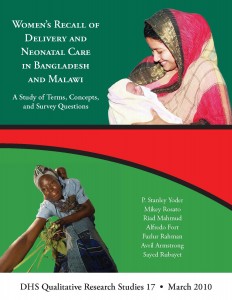
This study was conducted for Save the Children US/Saving Newborn Lives (SNL) to provide information for use in the formulation of survey questions about giving birth, immediate newborn care practices, and postnatal care. The overall study objective was to provide guidance on what questions can be reasonably asked in a newborn care module prepared for use in large sample surveys. Of greatest interest were the events that followed delivery and that involved newborn care and postnatal care for the mother and the newborn. The research considered whether or not the events asked about were usually recalled by women, whether or not the terms used were clear to respondents, and whether the answers provided could be easily and unambiguously coded. We also reflected on how well respondents understood the questions about a ‘health check’ for themselves and the baby and on challenges in interpreting survey data collected on health checkups.
Methods
Staff at ICF Macro designed and directed this study in collaboration with SNL staff and with local colleagues in Malawi and in Bangladesh, both countries where SNL has large programmes to improve neonatal, child, and maternal health. Macro worked with personnel from the MaiMwana project in Malawi and with personnel from the SNL programme and the Centre for Injury Prevention and Research of Bangladesh (CIPRB) in Bangladesh. About 80 women were interviewed about their most recent birth in each country: 40 who gave birth in a health facility and 40 who gave birth at home. Fifty percent of the women had given birth one to three months earlier, and 50 percent had given birth one to two years ago. Individual interviews consisted of two parts: part 1 was a loosely structured conversation, and part 2 was a structured questionnaire. Part 1 was recorded and transcribed, while part 2 responses were entered into SPSS for analysis.
Key events
The narrative section provided evidence about the events that women recall consistently. Women easily spoke about labour pains, the delivery process, cord cutting and cord tying, and delivery of the placenta. They gave specific times for commencement and termination of labour. Women paid attention to how and when the placenta was delivered, as they recognized the dangers of a delayed placenta delivery. Women also talked about wiping, wrapping, and bathing the newborn. The recordings and transcriptions of the narrative section show the terms and concepts that women used to describe all of these events in the two local languages: Chichewa in Malawi and Bangla in Bangladesh. Responses to the structured questionnaire provided additional evidence about the terms most easily understood, as it included questions about care of the cord; wiping, wrapping, and bathing the newborn; and postnatal care for the mother and newborn. The glossaries prepared for the two languages identify terms and concepts that can be used to formulate survey questions.
Some experts have suggested that the delivery of the placenta be used as a point of reference in survey questions. Women’s descriptions certainly showed that they paid very close attention to the delivery of the placenta, for a delay in delivery was always of concern. However, the study teams in both countries found that the timing of the delivery of the placenta varies widely from woman to woman. Therefore, the delivery of the placenta is not a suitable point of reference for other events such as wiping or wrapping the newborn. We recommend that survey questions that use the delivery of the placenta as a reference point be dropped.